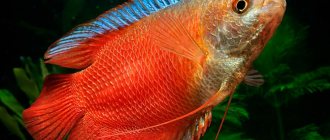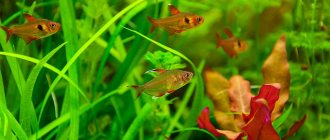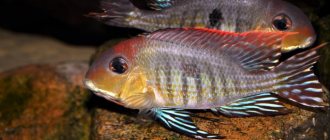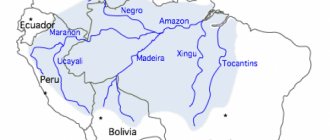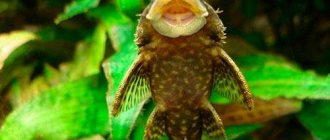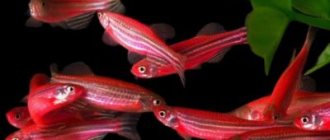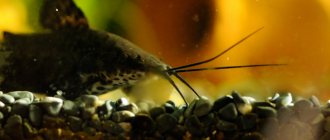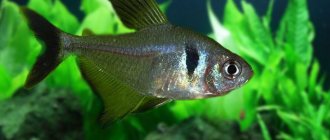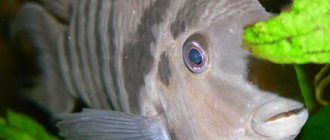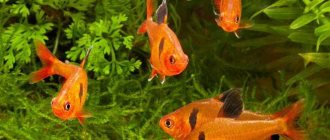This underwater inhabitant can be mistaken for a loach or an eel, but in fact it is an unusual, spectacular fish, rarely found in home aquariums. The thing is that macrognathus is quite difficult to keep; its offspring can only be obtained by using hormones, and acquiring such an original pet is not so easy. Experienced aquarists say that if the opportunity to have a macrognathus comes up, then you should not miss it under any circumstances!
general description
As already noted, macrognathus do not belong to loaches or eels; they are fish from the proboscis family, and not the largest representatives. The most common species found in home tanks are the Makrognathus aculeatus species - Macrognathus ocellitus. The scientific name of macrognathus is mastacembelus, they look like eels:
- they have an elongated, elongated body , similar to a snake;
- small head ;
- proboscis with a pointed point;
- the backs of individuals are decorated with numerous sharp spines;
- pectoral fins are absent;
- the dorsal and subcaudal fins are similar to the tail, they are light brownish or reddish;
- on the dorsal fin there are dark-colored dots with a golden outline;
- the main body color is brown, with a light brownish or olive tint;
- on the sides there is a marble-colored pattern with fuzzy lines;
- there are yellowish spots and lines on the body and head;
- a whitish stripe crosses the body on both sides;
- the tummy is lighter.
In nature, individuals grow up to 40 cm in length; in captivity, their size most often does not exceed 25 cm. Females are larger than males.
Mr. Tail Recommends: Variety of Species
Representatives of the family are divided into 2 groups: Macrognathus and Mastacembel. The differences between them are minimal, mainly in color and size. The table shows the most popular types of each group.
| Group | Variety | Description and length (cm) |
| Macrognathus | Siamese or ocellated | Beige-brown body color with light transverse stripes. Spotted dorsal fin. It can eat smaller inhabitants of the aquarium. 30. |
| Pearl | The body is brown with a silver tint. 17. | |
| Aral | The body is olive or brown, with a horizontal stripe on the sides. Dark and light brown spots on the fin. 60. | |
| Mastacembel | Coffee | The body is coffee colored with beige spots and vertical lines. Very friendly. 15. |
| Red Striped | The largest species. Black or dark gray striped body with red or yellow lines. The fins have stripes of the same shade. Neighborhood is acceptable with proportionate individuals. 100. | |
| Armatus or armored | The body is light brown with dark spots. Gets along with large individuals. 70-90. | |
| Moore | Exotic view from African Lake Tanganyika. Light brown color of the fish with spots. Neighborhood with large individuals is allowed. 40. |
Macrognathus in nature
The homeland of these unusual inhabitants is the territory of Southeast Asia. They are found in Indian, Thai, Sri Lankan reservoirs, Myanmar, Burma, and rarely in Sumatra. They inhabit fresh water, but are also able to live in slightly brackish water environments. In India and Burma, macrognathus are highly valued as a delicious, rare variety of fish.
In their natural environment, they prefer to be active at night. They burrow into the ground, and only their small head remains on the surface. Thanks to their graceful physique, these inhabitants are able to squeeze into narrow crevices between stones. They often choose areas with old, flooded snags and abundant thickets of aquatic vegetation.
Macrognathus is a predatory fish, the basis of its diet is small fish, fry, crustaceans and other small aquatic inhabitants.
Keeping Macrognathus in captivity
It is not recommended for beginners to have such controversial pets; they require special care and specific living conditions. Moreover, special attention should be paid to arranging a home for Macrognathus ocellata. The requirements for the aquarium are as follows:
- minimum volume – 100 liters;
- It is necessary to have a tight, reliable lid;
- soil is necessary - it is important that there are no sharp elements;
- Macrognathus need vegetation, and since these fish love to rummage in the soil and can easily damage the root system, it is recommended to plant crops with a strong root system, or plants in pots;
- stones are large, with a smooth, polished surface, these inhabitants use them to rub themselves and get rid of excess mucus;
- groups of driftwood without sharp edges are excellent shelters for snake-like, nimble fish;
- The water temperature should be between 21°-26°C.
When the house for macrognathus is ready, it is worth taking a closer look at the environmental conditions in which these inhabitants will be as comfortable as possible:
- water – must be clean, care must be taken to maintain certain parameters;
- filtration and aeration systems are a must for these inhabitants;
- water changes are carried out once a week by 30-35%;
- pH not higher than 15°dH;
- acidity – 6.5-7;
- individuals do not need bright lighting, it should be dim;
- At night, the tank must be covered with a glass lid.
To prevent the development of pathogenic flora in the tank, it is recommended to place antiseptics in the tank - “methyl blue” and “malachite grun”.
Aquarium Basics
For your pet to have a comfortable life in the aquarium, proper care must be taken. The following conditions must be adhered to:
- tank volume is at least 100 liters;
- water quality and purity are high;
- weekly replacement of about 30% of the fluid volume;
- good aeration and filtration;
- temperature about +21…+27 °C;
- acidity no more than 7 pH;
- hardness below 15 °dH;
- dim light, reminiscent of the natural lighting of Asian bodies of water, must be turned off at night;
- water salinity control;
- the presence of aquarium plants and soft soil;
- It is necessary to have a reliable lid for the aquarium; the eel can crawl out of it.
Features of feeding and diet of macrognathus
Future owners of these pets should understand that they are not omnivores and are quite picky eaters. At home, they will have to be fed delicacies, seafood, live and frozen food:
- pieces of peeled squid;
- cod - fillet;
- small fish, including weeds.
These fish will not refuse earthworms and various invertebrates. You can offer your fish a high-quality dry diet, but most likely they will not accept it as an edible product. By the way, if the macrognathus decides that the conditions and feeding offered by the owner are not suitable for it, it can get out of the tank during the day and go in search of a more suitable home.
Feeding
Aquarium eels are notorious for being difficult to feed. They are generally shy and will take weeks, if not months, to settle into a new location.
It is important to provide them with adequate feeding during this period. Since spiny eels are predominantly nocturnal, they need to be fed at sunset. Asian species are less fastidious and eat bloodworms and small fish, but are especially fond of worms.
Africans take only live food, but over time they can be accustomed to freezing and artificial food. Since eels are shy, it is better not to keep them with catfish or loaches, which are more active and will devour everything in a moment.
Diseases and treatment
Macrognathus are the most vulnerable to dermatological diseases. They love to burrow into soil material; if they are deprived of this “pleasure,” they begin to get sick. Due to their underground lifestyle, the skin of individuals produces a large amount of mucus; it is needed for wiping during the process of immersion in the ground. And if there is no substrate in it, the mucus does not go away, provokes inflammatory processes, and the skin of the fish becomes covered with ulcerations.
To rid your pet of this disease, it must be treated immediately at the first signs, at the initial stage:
- the temperature of the water in the tank should be gradually increased to 32°;
- increase the salinity of the environment to 10%;
- The following medications are added to the aquarium: Ericicline and Griseofulfin (dosage as recommended by a veterinarian or based on the instructions);
- The water should be changed more often than usual.
If you react in a timely manner and do everything correctly, you will be able to cure macrognathus.
Diseases and prevention
The main diseases for Macrognathus are:
- Skin diseases. The skin of fish secretes mucus, which they get rid of by burrowing into the bottom. If this is not possible, the mucus causes inflammation and subsequent intractable illnesses.
- Poisoning. Increased content of chlorine and nitrogenous compounds, as well as insufficiently clean soil, contribute to this.
- Ichiophthiriasis. White pimples appear on the skin. It is treated with special medicines for scaleless animals.
- Temperature shock. Occurs due to a sharp change in water temperature. Be sure to keep the same one all year round.
- Oodiniumosis. A copious amount of yellowish mucus appears, and the pet begins to itch on the surface. The drug Bicillin-5 is used for treatment. Before use, you should carefully read the instructions, as it may cause harm to other inhabitants.
Who do macrognathus get along with?
Macrognathus are not particularly sociable inhabitants; most often they do not pay attention to their neighbors unless they are the fish that they feed on. With related species, everything is much more complicated; they can treat them either neutrally or extremely aggressively. As a rule, representatives of the Mastacembela species are more territorial, while Macrognathus are more tolerant of relatives and other inhabitants.
As for intraspecific relationships, in a group consisting of 2-3 individuals, weak brothers may not fare well, especially if they live in a cramped aquarium or there are no shelters in it. Some aquarists prefer to keep only one macrognathus, although in a flock they adapt faster.
We should not forget about the danger that these inhabitants pose for humans. If you take the fish in your hands, you can not only damage your skin on its sharp thorns, but also suffer from the poisonous mucus that has penetrated into the wounds.
Compatibility with other types
Macrognathus is not aggressive, but if there are small fish in the aquarium, it may begin to hunt them. It is better to purchase young fish in small schools (this will help them survive adaptation). It is better to keep adult individuals separately. It is not recommended to keep many individuals in one aquarium, because conflicts often arise between males over territory or during spawning. Sedentary fish are good:
- gourami;
- battles;
- parrotfish;
- mistuses;
- catfish.
Keeping cichlids with cichlids is strictly not recommended due to the mobility of this species, due to which macrognathus can mistake the cichlid for its prey and eat it.
It is recommended to place bottom species with macrognathus, which are peaceful, as well as large and active fish.
If you take Macrognathus with bare hands, you can injure yourself on its dorsal spines and cause an infection. This type of fish prefers a solitary settlement, but quickly adapts in a group.
Breeding Features
Fish of this species reach sexual maturity by 2 years of age. Moreover, obtaining offspring from adults without the use of special hormonal stimulation is a huge success. Most often, without such “doping” they do not spawn. The effectiveness of spawning depends not only on the competent preparation of future parents, but also on providing the spawning tank with the necessary parameters and decor:
- as a spawning tank, you should use at least a 250-liter container, the length of which should be at least a meter;
- Before use, the tank is thoroughly cleaned with soda and rinsed thoroughly;
- Only settled water with the same parameters as in the general tank should be poured into the spawning tank;
- gradually the water temperature is increased to 26°-28°C;
- decorate the container mainly with objects that can act as shelters - clay pots, shards, ceramic or plastic tubes;
- It is advisable to use bushy vegetation as a substrate - microzorium or bolbitis.
Then you can proceed to the next preparatory stage, which concerns manufacturers:
- a couple of weeks before spawning they need to be fed generously with live food;
- the water temperature should remain at 25°;
- when it becomes noticeable that the female has become round and eggs are visible through her abdomen, she can be placed in a spawning tank, having first injected a hormonal drug into the back. Usually they are given choriogonin or gonadotropin - 100 units for one adult, administered with a smaller amount of solvent - 0.23 cm3;
- The tank is placed in a shaded place; you can block its walls with dark sheets or cloth and, if possible, do not disturb the fish.
During the spawning period, it is desirable that there is a current in the tank created by aeration. Females lay eggs on plants or other surfaces. You can understand that the spawning process has completed by the behavior of the individuals. Their activity noticeably decreases, they begin to hide in secluded places. If this happens, the parents can be returned to the aquarium, and then keep an eye on the future offspring.
After 24 hours, the eggs hatch into fry, which begin to swim not immediately, but after 2-3 days. As starting food, you can use standard food for fry - live dust, plankton, liquid food.
In the resulting “kindergarten,” cases of cannibalism are not uncommon. Therefore, in order to preserve as many individuals as possible, it is recommended to sort the offspring, placing fry of different sizes in different containers. The bottom of the sedimentation tank should be covered with river sand, Java moss, equipped with a filter, and later with a compressor with aeration.
Macrognathus are quite complex inhabitants, but still there are many who want to have such an extraordinary creature. They are too unusual and original.
Breeding rules
Breeding these animals is a complex process and is carried out by experienced aquarists. In order for spawning to begin, special hormonal injections into the dorsal muscle of the fish are required.
For reproduction, equip a large shaded container (spawning tank) with clean water, aeration, and a net at the bottom. The net is needed to prevent the fish from eating the eggs that fall to the bottom. A female and 1-2 males are placed in the spawning tank and fed generously. After spawning, the adults are removed.
The fry hatch from the eggs in 1-3 days. They are fed brine shrimp and microworms. The grown fry are transplanted into separate containers.
